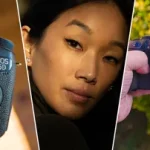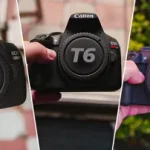Hey guys. Today we’ll have a look at an older camera, released all the way back in February of 2011, when I was still in highs cool. If that makes you feel old, I’m really sorry. So the camera in question is the Canon EOS 600D, also known as Canon Rebel T3i, or EOS Kiss X5.
Even at the time, this camera was entry level, so what possible use could it have in 2022 and beyond? Let’s delve a bit deeper into its specs, as you might be surprised.

Size & Build
As you might expect, the camera isn’t particularly large, weighing in at 570g, or 20.11 oz. The body measurements are 133 x 100 x 80 mm.
This isn’t going to be a particularly large camera, even for a newcomer, which might actually make it ideal. I love carrying my R5, with its beefy RF lenses around, but if you’re just getting started, something like the 600D + an 18-55mm kit lens might be bulky enough.

Image Quality
Now, let’s talk about image quality. As it is to be expected from an 11 year old entry-level camera, it does not have any built-in image stabilisation. You can pop an 18-55mm IS kit lens on it, and that will give you some, though there isn’t any communication between the lens and body, like in the case of the R5.
By the way, if you want to learn more about the 18-55mm kit lens, I’ve reviewed it on my channel.
When it comes to the images, as you might expect of an 18MP APS-C sensor, detail and resolution are both quite good, producing quality RAW files that take up about 20MB each.
No matter whether you’re a beginner or a pro, shooting in RAW is one of the best things you can do for your photography. Not only do you capture more detail this way, but you also have more leeway when it comes to adjusting exposure in post production.
If you’re worried about focus, this camera has Contrast Detection and Phase Detection autofocus systems.
Unfortunately, the camera does not have Dual-pixel autofocus, which wasn’t introduced until 2013.
The AF system has 9 focus points, where one of them is Cross-type. Cross-type sensors lock focus faster and more accurately, at least compared to single type sensors.
The Canon 600D also features intelligent Face detection AF where it detects faces in the frame, and locks the focus automatically. This feature only seems to be available in Live View mode, though I could be wrong about this.
Here are some photos I took with the Canon EOS 600D.
Creative Filters
As many other entry-level cameras, the 600D gives you the option of creative filters. Personally, I would not bother with those. Whatever the camera can do, you can do in Lightroom or Photoshop, whilst retaining a clean RAW file to work with, and having way more flexibility.
Plus, you’ll learn a lot more by manipulating your images that way, as opposed to allowing the camera to slap a filter on it, and call it a day.

Display
The T3i is equipped with a swivel screen. Not only does this make it easier to shoot at odd angles, but when the camera is not in use, you can flip the screen around, thus protecting the screen from scratches or impacts.
The screen is not touch sensitive though, which is to be expected.
In terms of quality, the screen itself is nothing spectacular, especially by modern standards, but it can show you photos that you’ve taken, it allows you to navigate the menus, and it allows you to see yourself whilst filming.
I’m pretty sure that’s all that that screen is needed for, so as far as I’m concerned, it ticks all the boxes.
Control
To those who have used Canon cameras before, the button layout will be familiar. You have a menu and info button in the top left corner, next to the viewfinder, a mode dial that can select shooting modes on the top right, and so on.
Nothing particularly revolutionary here. If you’re a newcomer, I’d recommend having a quick look through the manual, to learn what each button does.

Connectivity
If you have vloggy aspirations, you have a port where you can connect a microphone to the camera, like a Rode Videomic Pro, for example, but you do not have a headphone port.
Vlogging
Speaking of vlogging, would I recommend this camera for it? Not really, unless you sit down for your videos. Given that the camera does not have Dual-Pixel AF, focusing whilst on the move might be tricky.
We have indeed been spoiled by better and better Auto Focusing systems, so it might just be the fact that I’m fussier about AF than most, but if you’re going to spend the money, get something like the Canon 77D, which does have Dual-Pixel AF.
Storage
When it comes to storage, the EOS 600D has only one SD card slot, which is to be expected. If you want to use this camera to start photographing events, you’re taking a bit of a risk, as if the SD card fails, you have no backup.
For events, or professional jobs in general, it’s usually recommended that you use a camera with two card slots, like the Canon 7D Mark II for example, which I’ve also reviewed on my YouTube channel.
I understand that the 600D is an entry level camera, and most people wouldn’t consider using it for professional use, but I’ve done professional corporate headshots with a Nikon D3200. At the end of the session, I’d rush to my laptop, and copy the files off the SD card, just in case.
We all have to start somewhere.
Battery Life
When it comes to battery life, it’s not really impressive. A new battery would give you around 440 shots, and that’s assuming that the battery itself is new, which if it’s an original one, it probably won’t be.
Having a few is always a good idea, especially if you’re not sure how long you’ll be shooting for.
Longevity
When it comes to longevity, the T3i is rated for 100,000 actuations. That means that you can take 100,000 photos before the shutter, theoretically, fails.
Given the age of the camera, and the fact that you’re almost guaranteed to purchase it in a used state, it’s good to look at how many photos the device has already taken, before making the purchase.
If you find it on eBay for example, look at the description for the number of actuations. If they’re not stated, message the seller. Now, if they refuse to tell you, that’s probably because it’s close to the maximum, and you should just look elsewhere.
In terms of weather sealing, it basically has none. The Rebel series just isn’t designed to be used in harsh conditions. Getting water inside of it, or dust, or sand, could very well brick the camera, so do be careful.

Video
We’ve addressed vlogging a bit earlier, but let’s talk a bit more broadly about the video capabilities of this camera.
You can do 1080p at up to 30fps, or 720 at up to 60fps. Decent for the time, not great for 2022.
This camera might have been ok for video when it was first released, as autofocus was generally pretty bad across the board, but if your videos will be judged by modern standards, you’ll probably be wishing for better AF.
Autofocus can also be noisy when filming. If you’re shooting B-Roll, this won’t be a problem, as the sound won’t matter, but if shooting an interview for example, and you’re using the built-in audio, or even a microphone on top of the camera, you might run into trouble.
If you’re using an external mic to record the interview, which you should be doing, this may not be an issue, depending on the acoustic properties of the space you’re filming in, but if not, you might be better off using manual focus.
Plus, I’m not sure I’d trust this camera for interviews, as people tend to move around, so unless you’re willing to focus manually, I’d look at something else.
Compatible Lenses
The T3i is compatible with EF and EF-S lenses, which means that you have an almost inexhaustible list of glass you can use with it, not only from Canon, but from third-party manufacturers as well.
Given that it’s an entry level camera though, you’ll probably stick with the basics, like either the 18-55mm kit lens, maybe a Canon 50mm f1.4, or possibly even the Canon 75-300mm lens. I’ve reviewed all of those lenses on my YouTube channel, wink wink.
Conclusion
And now, for the conclusion. Should you buy the Canon 600D?
If you’re looking for your first camera, and you want to learn on it, I’d say go for it. You can easily take great photos with it, if you know what you’re doing, and the only way to know what you’re doing is by practicing.
I’d stay away if you want to do anything more than basic video, but for photos, it’s still a great option, generating RAW files that are rich with detail, and thus allowing you to practice working in post production as well.
For anything else, I’d stay away, and I’d instead read my reviews of the Canon 250D, or Canon 77D, as both cameras are somewhat higher end, but still affordable, especially the 77D.
If you’d like to purchase any of the items I’ve mentioned in this article, or see how much they cost in your country, I have a link down below where you can view them.
Thank you for reading my review of the Canon 600D. I invite you to have a look at some of my other articles. We have something for everyone, whether you’re interested in audio, or cameras and lenses. Alternatively, if you prefer video reviews, feel free to have a look at my YouTube channel.
Product Links
Down below you will find all of the items I talked about in this article.



